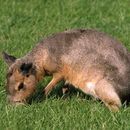Biology
provided by Arkive
In keeping with its strange appearance, the Patagonian mara displays behavioural traits that are very unusual among the rodents. Active during the day, this species spends long periods basking in the sun, either resting on its haunches or with its front limbs folded under its body like a cat. It remains vigilant for predators, however, and when threatened, may escape by galloping or stotting, a high-speed form of locomotion involving rapid bounces using all four limbs at once. Surprisingly, this diminutive species can reach speeds of 45 kilometres per hour over distances in excess of one kilometre. The Patagonian mara consumes a variety of vegetation, usually feeding in grass or shrubland during the day and sheltering in an abandoned burrow of another species, or amongst dense vegetation at night (2).
Perhaps the most unusual feature of this species is its social and reproductive behaviour. Patagonian maras are strictly monogamous (a rare trait in mammals), forming lifelong pairs that generally avoid contact with conspecifics, except during the curious arrangements that form in the austral summer breeding season. The female Patagonian maras dig burrows, in which the young are often reared communally (2) (3). After a gestation period of 90 days (3), the female gives birth to a litter, usually of two young, close to the entrance of a burrow (1) (2). The young, which are born well-developed, with eyes already open, quickly move into the burrow, which may be co-habited by the offspring of several other breeding pairs (2). The young remain in the vicinity of the burrow for the next four months, where they are visited daily by the mother to be suckled. When the breeding pair visits the burrow, the female makes a shrill call, which brings all the infant Patagonian maras in the burrow to the surface. The female then attempts to discern its own offspring within the group by smell, while chasing off the young of other pairs, which try to, and occasionally succeed, in obtaining the female's milk. Once identified, the female leads its offspring a short distance away from the burrow to be fed, while the adult male keeps watch, chasing off other pairs that approach. The other breeding pairs must therefore wait until the preceding pair have departed, before visiting the burrow. This communal behaviour is thought to help reduce predation, as it means that adults are more frequently present around the burrow (3).
Conservation
provided by Arkive
At present, the Patagonian mara is found in at least 12 protected areas within its range (1), where it received varying degrees of protection against habitat loss and hunting (4).
Description
provided by Arkive
With long hare-like ears and a body resembling a small deer, the Patagonian mara is a distinctly unusual looking rodent (3). The upperparts are brownish grey, with a darker patch on the rump bordered below by a white fringe, while the underparts are whitish (2) (3). The body is well adapted for running, with long, powerful hind limbs, ending in three digits, each bearing a hoof like claw. In contrast, the front limbs are shorter, with four sharp claws that help this species to dig burrows in which the young take refuge (2).
Habitat
provided by Arkive
The Patagonian mara inhabits lowland areas of coarse grassland or open scrub desert, but may also occur in forests (1) (2) (3).
Range
provided by Arkive
The Patagonian mara is endemic to Argentina, where it is widely distributed. Two subspecies are currently recognised: Dolichotis patagonum centricola, which occurs in the north within the provinces of Catamarca, La Rioja, Cordoba and Santiago del Estero; and Dolichotis patagonum patagonum, which occurs from the province of Mendoza, east to Buenos Aires, and south as far as Santa Cruz (1).
Status
provided by Arkive
Classified as Near Threatened (NT) on the IUCN Red List (1).
Threats
provided by Arkive
As a result of habitat loss, hunting and competition with large introduced herbivores such as sheep and the European hare, the Patagonian mara population is undergoing a worrying decline. In Buenos Aires Province, hunting for this species' skin and clearance of its habitat for agriculture has resulted in localised population extinctions. Unless measures are taken to mitigate the threats to this species, it is likely that it will soon qualify for threatened status (1).

